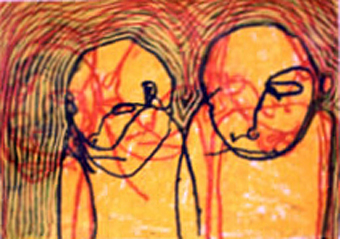






by Luca Panaro

Why do you always paint self-portraits?
My work is about the different elements that make up a person -
physical, emotional, mental and spiritual - and the way we understand and communicate these elements to others. The reason I paint
self-portraits is because I naturally reflect on these elements within
myself every day. It takes a long time to get to know how a person
really works inside and even then you will never know them completely.
The only other people I have painted in this way are people I know very
well, people I love. Although I have been known to paint a dog, I used
him as a way to represent anger by annoying him until he snarled at me
then I made quick sketches straight on to the painting. But really the
only person you can ever truly know (and truthfully represent) is
yourself.
Describe the reason for the camera performance that accompanies your
paintings. Does it relate to the mirrors used in your painting process?
The reason for the performance is to reflect on the process of painting
and to bring the action out of the studio and into the gallery. The
action of painting is just as important to me as the finished piece. To
see an artist working strengthens the viewers understanding of the work,
and it forces you to look at the process that may have gone into the
other pieces on display. The performance brings back a lot of the human
element that is usually lost in the transition from the place of it's
creation to the white walled spaces it is destined to be exhibited in.
It also reflects on the way art is distributed and reproduced in today's
society.
Why are your drawings abstracted?
As I have mentioned, my work is a reflection on the different elements
that make a person who they are. Although my paintings are
self-portraits I prefer them to have a life/self of their own.
Abstracting the image stops it from only being about me.
Usually when producing a drawing an artist concentrates on the subject
then translates that image to the surface, constantly looking from one
to the other. The process of abstraction that I use is to concentrate
more on the subject than the drawing. Sometimes I will not look at the
drawing at all. This process allows me to become the audience as well as
the creator. From the moment I look at the finished drawing I can see it
in the same way that any other viewer will look at it. I can see it with
fresh eyes and then try to understand it's own unique character for
myself.
From that point on I try and interpret how the figure I have just drawn
may be feeling. Is its head low and sad, or are its shoulders slumped. I
try and read the drawings body language in the same way that I would
understand a real person. I then reflect on those feelings and begin to
add extra strength by means of symbols such as patches of colour or
arrows depicting movement, emotion or communication. By the time the
painting is considered finished it will have taken on a life of its own.
It is made up using elements of me yet it has become someone else. It's
like looking at yourself in a fairground mirror and no longer
recognising the reflection staring back at you.
What types of colours and supports do you use?
The way I work and the processes I use tend to mean my paintings are
quite quickly produced. This is an important element in capturing and
understanding the figures I draw. So the materials I use tend to be
those that are either quick drying or easy to manipulate. I usually use
acrylic paints and a mixture of chalk pastels and oil sticks. I prefer
to work on smooth surfaces such as paper or well-primed canvas because
it ensures a clean line from the pastels. However I have also been known
to work on boards, screens and straight onto walls (my studio is usually
covered in drawings and lines that exceeded the diameter of the surface
I was working on). For the gallery performance I like to use slate
blackboards whenever possible, because they have such a smooth surface
and produce the best drawings however temporary that drawing may be. The
piece produced during the performance will often be destroyed after the
show, leaving only the video and photographic evidence as proof that it
existed.
Why do you title your work with roman numerals?
The roman numerals represent the number of paintings produced in any
given year up to that point. They serve two purposes. Firstly they
reflect the documentation within my work. I feel like each piece is a
still moment in time capturing the emotional, physical, mental and
spiritual state of the character in the drawing. In some pieces the work
shows a snapshot of my own state at the time of production. I often
understand the reasons behind the emotions in my paintings better when I
return to them at a later date, this is because I can look at it afresh
and remember whatever was affecting me at the time of production.
The second purpose is that in using numerals rather than titles I am
leaving the interpretation of the painting open to the viewer's own
understanding. I like people to come and see elements in the painting
that relate to their own experience and state of being. This enables the
viewer to enjoy the piece on a far more intimate level.
15 october 2002